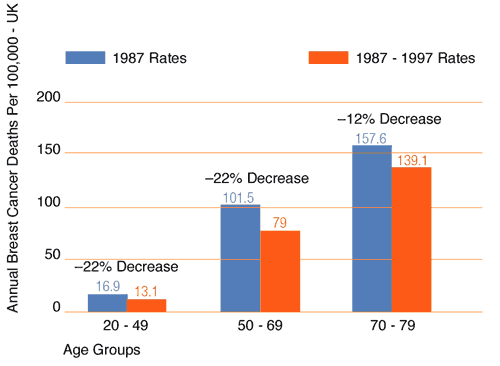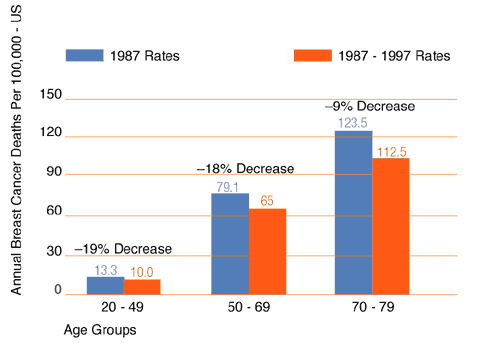Section 10
Predictions of
Future Trends in Breast Cancer Research
BEYOND
ATAC: FASLODEX® (fulvestrant)
This is
a very interesting agent. I was a co-author on one of the
very early Phase 1 studies looking at the mechanism of action.
Surprisingly, as well as it being a pure antiestrogen, Faslodex
is an estrogen receptor downregulator. It’s an extraordinarily
elegant molecule. Biologically, it’s very attractive,
because there’s no other molecule that works as an estrogen
receptor antagonist and downregulator, and also as an antiangiogenic
agent. We are looking for a trial to replace ATAC, and we
are considering evaluating conventionally timed versus perioperative
endocrine therapy. It’s amazing that such trials have
never been done. There are trials of neoadjuvant chemotherapy
but none on endocrine therapy. Faslodex lends itself to that,
because of its rapid effects on the tumor in situ, and you
can measure surrogate markers. We would like to take the best
arm of the ATAC trial and compare that with Faslodex in a
factorial way — looking at drug against drug and timing
against timing. Hopefully, we’ll have a pilot protocol
ready to go next year. This type of trial — where you’re
looking at the tumor intact — can be a gold mine in the
search for the valuable surrogate markers of response.
—Michael
Baum, ChM, FRCS
| Howell
A, Osborne CK, Morris C, Wakeling AE. ICI 182,780
(Faslodex): Development of a novel, ‘pure’ antiestrogen.
Cancer 2000;89:817-25.
Abstract |
NEOADJUVANT
SYSTEMIC THERAPY
The future
of preoperative therapy will be in the biologic arena. In
our first trial — NSABP B-18 — we saw some interesting
biology. Tumors decreased in size and lymph node status was
down-staged, but the ultimate disease-free survival was no
different than with postop chemotherapy. However, we did observe
a correlation between clinical response and long-term outcome.
In a sense, this was a predictor for who would benefit from
chemotherapy. Currently, there’s a lot of research looking
at ancillary studies on these pre-treatment tumors, doing
molecular biology and gene arrays to help predict response
to chemotherapy. I think this type of research will be very
important during the next decade.
—Richard
Margolese, MD
| NSABP
B-18: Phase III Comparison of Preoperative vs Postoperative
Short-Term Intensive Combination Chemotherapy with
AC (DOX/CTX) in Women with Resectable Carcinoma
of the Breast (closed to accrual)
Protocol |
|
ARM 1 |
Surgery |
 |
AC x 4 |
|
ARM 2 |
AC x 4 |
 |
Surgery |
Tamoxifen
given if > 50
y/o
Fisher
B, et al. Effect of preoperative chemotherapy
on the outcome of women with operable breast cancer.
J Clin Oncol 1998;16(8):2672-2685.
Abstract
|
|
TARGETED
TREATMENT AND PREVENTION
In
treatment, we already have the estrogen receptor and HER-2
to guide us in using endocrine therapy and Herceptin. I think
there’s going to be a lot more of that, and we’re
going to be able to tailor therapies based on the specific
breast cancer. Prevention is probably going to go much the
same way. The problem with prevention trials is that unless
we develop better biomarkers, we’re never going to be
able to do the studies. We struggled to do a study of 15,000
women looking at tamoxifen for five years. To sort out the
effects of something like soy, we’re talking about a
ten-year trial of more than 40,000 women. The logistics of
that are horrendous. Better biomarkers would allow us to assess
interventions within a year or two in a few thousand women.
We would learn how to better use the agents we already have,
and there’s going to be a whole range of new ones to
look at, like the anti-angiogenesis agents and the tyrosine
kinase inhibitors, like Iressa® (ZD 1839).
—Jack Cuzick, PhD
PREVENTION
I
think we will refine our ability to assess risk with interventions
like ductoscopy and potentially ductal lavage — although
at this point, our knowledge about that technique is in its
infancy, and it’s far from standard practice in the evaluation
of high-risk women. But it is potentially an exciting new
development. In terms of newer chemoprevention strategies,
tamoxifen was a wonderful first step — but it’s
clearly not the answer for everyone.
—Monica
Morrow, MD
|
Dooley W et al. Ductal Lavage and Detection of Abnormal
Cytology in Women at High Risk for Breast Cancer.
Poster, 2001 Miami Breast Cancer Conference.
Full-Text
Evron
E et al. Detection of breast cancer cells in ductal
lavage fluid by methylation-specific PCR. Lancet
2001;357(9265):1335-1336.
Abstract
|
DEATH
RATES
Mortality
from breast cancer will continue to fall because of an accumulation
of modest incremental advances. I also predict that chemotherapy
has nowhere to go, and we’ll be using less of it. There
will be greater use of endocrine therapies, particularly in
premenopausal women, and we should have good data on aromatase
inhibitors, Faslodex and combinations of endocrine therapies.
I also predict that over the next decade, all the excitement
over the human genome project and the molecular biology of
breast cancer will be translated into zero clinical impact.
We just got carried away by the sheer weight of publication;
we know more and more about less and less. A lot of people
are excited about microarray technology, but the problem is
that there isn’t even the computer-based neural networks
to analyze these data. That’s why within the next ten
years, I don’t think we’ll see anything. Maybe in
20 years.
Michael
Baum, ChM, FRCS
ANNUAL
BREAST CANCER DEATH RATE PER 100,000 WOMEN IN THE UNITED
KINGDOM, 1987-1997

Peto
R et al. Lancet 2000;355(9217):1822.
|
ANNUAL
BREAST CANCER DEATH RATE PER 100,000 WOMEN IN THE UNITED
STATES, 1987-1997

Peto
R et al. Lancet 2000;355(9217):1822.
|
|
